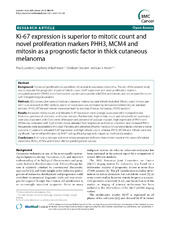| dc.contributor.author | Ladstein, Rita Grude | en_US |
| dc.contributor.author | Bachmann, Ingeborg M. | en_US |
| dc.contributor.author | Straume, Oddbjørn | en_US |
| dc.contributor.author | Akslen, Lars A. | en_US |
| dc.date.accessioned | 2011-01-05T13:11:01Z | |
| dc.date.available | 2011-01-05T13:11:01Z | |
| dc.date.issued | 2010-04-14 | eng |
| dc.Published | BMC Cancer 2010, 10:140 | en |
| dc.identifier.issn | 1471-2407 | |
| dc.identifier.uri | https://hdl.handle.net/1956/4386 | |
| dc.description.abstract | Background: Tumor cell proliferation is a predictor of survival in cutaneous melanoma. The aim of the present study was to evaluate the prognostic impact of mitotic count, Ki-67 expression and novel proliferation markers phosphohistone H3 (PHH3), minichromosome maintenance protein 4 (MCM4) and mitosin, and to compare the results with histopathological variables. Methods: 202 consecutive cases of nodular cutaneous melanoma were initially included. Mitotic count (mitosis per mm2) was assessed on H&E sections, and Ki-67 expression was estimated by immunohistochemistry on standard sections. PHH3, MCM4 and mitosin were examined by staining of tissue microarrays (TMA) sections. Results: Increased mitotic count and elevated Ki-67 expression were strongly associated with increased tumor thickness, presence of ulceration and tumor necrosis. Furthermore, high mitotic count and elevated Ki-67 expression were also associated with Clark's level of invasion and presence of vascular invasion. High expression of PHH3 and MCM4 was correlated with high mitotic count, elevated Ki-67 expression and tumor ulceration, and increased PHH3 frequencies were associated with tumor thickness and presence of tumor necrosis. Univariate analyses showed a worse outcome in cases with elevated Ki-67 expression and high mitotic count, whereas PHH3, MCM4 and mitosin were not significant. Tumor cell proliferation by Ki-67 had significant prognostic impact by multivariate analysis. Conclusions: Ki-67 was a stronger and more robust prognostic indicator than mitotic count in this series of nodular melanoma. PHH3, MCM4 and mitosin did not predict patient survival. | en_US |
| dc.language.iso | eng | eng |
| dc.publisher | BioMed Central | eng |
| dc.rights | Attribution CC BY | eng |
| dc.rights.uri | http://creativecommons.org/licenses/by/2.0 | eng |
| dc.title | Ki-67 expression is superior to mitotic count and novel proliferation markers PHH3, MCM4 and mitosin as a prognostic factor in thick cutaneous melanoma | en_US |
| dc.type | Peer reviewed | |
| dc.type | Journal article | |
| dc.description.version | publishedVersion | en_US |
| dc.rights.holder | Copyright 2010 Ladstein et al; licensee BioMed Central Ltd. This is an Open Access article distributed under the terms of the Creative Commons Attribution License (http://creativecommons.org/licenses/by/2.0), which permits unrestricted use, distribution, and reproduction in any medium, provided the original work is properly cited. | |
| dc.rights.holder | Ladstein et al | |
| dc.identifier.doi | https://doi.org/10.1186/1471-2407-10-140 | |
| dc.identifier.cristin | 349452 | |
| dc.subject.nsi | VDP::Medisinske Fag: 700::Basale medisinske, odontologiske og veterinærmedisinske fag: 710::Medisinsk biokjemi: 726 | nob |

